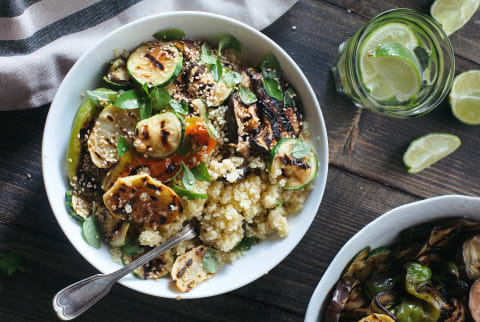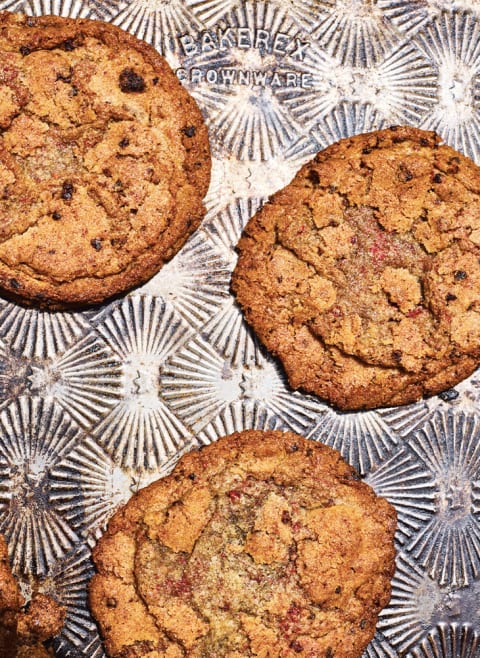Advertisement
The Vegetarian Recipes That Fit Into Every Busy Schedule

Busy weeks call for convenience. And all too often, that takes the form of takeout or grabbing whatever's in reach to satisfy hunger pangs and keep moving. But busy weeks also call for extra emphasis on wellness to stay on top of our stress levels and overall health. Luckily we can have both. Convenience and health come together (deliciously) in blogger and author Heidi Swanson's new cookbook, Super Natural Simple. Heidi's teaching us how to pack our meals with nutrition and flavor with dozens of vegetarian recipes that fit right into our full schedule. All we can say is, finally. When we can start the day with a French Onion Breakfast Strata—things flow a little more smoothly. No matter how busy we get, pausing to better nourish our bodies with simple recipes is always a good idea.
For a deeper understanding of what this cookbook's all about, check out the excerpt below and a recipe for Big Raspberry Rye Cookies. For more inspiration, purchase your own copy here.
Super Natural Simple
In 2007, I wrote Super Natural Cooking. It was a cookbook celebrating the power of natural foods at a time when cooking with whole grains and focusing on nutrient-dense plant-based ingredients wasn't as popular. Super Natural Cooking and its 2011 follow-up, Super Natural Every Day, highlighted a style of cooking and sourcing of ingredients that felt right to me. It made sense to eat real food and cook using mindfully grown, thoughtfully sourced ingredients. The case for vegetarianism (and veganism) was similar then to what it is now: better for the planet, better for the animals, better for our health and well-being.
In the years since, I've watched the coming and going of so many diet, eating, and cooking trends: Whole30, Atkins, low-carb, paleo, keto, turmeric-everything, warm lemon juice every morning, cupboards dedicated to smoothie powders, extensive supplement and vitamin programs, and on and on. It's an intense and often overwhelming ecosystem, created by networked information culture, food politics, and diet wars colliding with people who are genuinely hoping to find their way to balance and good health. Unfortunately, many people end up pingponging from one trend and headline to the next.
When you cut through all of the claims and look at communities with the strongest longevity pockets, communities with elderly populations that experience a good quality of life well into their 80s and 90s, you find common threads. These folks tend to eat a 90 to 100% plant-based diet. And they build meals around greens, whole grains, beans, nuts, and tubers. So while a lot of the information out there can be fun, inspiring, compelling, and, in many cases, helpful, finding your way to nutrient-rich, whole-food, plant-based meals is probably where you want to settle.
The trick, of course, is to identify and consistently integrate this type of cooking (and eating) into your life. My hope is that Super Natural Simple can step in here. If you are looking for approachable ways to work more vegetables and whole foods onto your plate, this book is for you. If you're looking for ways to phase out processed ingredients, restaurant meals, and takeout in place of super natural, weeknight-friendly meals, this book will help.
Natural foods and whole ingredients are wonderful, powerful, and often very beautiful. The magic (and benefits!) of integrating them into the rhythm of your life is real. Staying connected to what you eat is one of the most impactful ways to support your health and well-being. And modern life makes it so easy to disconnect with its bounty of prepared foods, restaurants, and delis.
When people ask me for advice about shifting to a more natural, plant-centric way of eating, there are a few key tips that I find myself expressing again and again. In practice, this advice comes together in a system of sorts, which I've outlined below. When you put these components in place, it's possible to create a positive ecosystem inside your own kitchen to help support you and your cooking aspirations.
- Transition to natural ingredients: Start with some simple swaps. Switch from white rice to brown rice. Or sprinkle a handful of cooked quinoa, millet, or barley into your white rice. Replace your standard pasta with a whole-grain or plant-based version. Introduce breads made with a percentage of whole grain or nut flours and dial up the percentage from there.
- Identify 10 recipes you love: Step 2 on your journey to eating more whole foods is to identify 10 recipes that embody the way you aspire to cook and eat. There is so much food and recipe content out there, and it is easy to get overwhelmed. Creating a tight list of 10 recipes helps you focus, shop, organize, and even delegate to other cooks in your household.
- Keep a well-stocked pantry: Having a full pantry of ingredient all-stars is one of the pillars of simple cooking. Good produce is the other.
- "Merchandise what you have: I do one simple task every week that affects how I feel about cooking more than just about anything else. You might see it as cleaning out the refrigerator, but I think of it as "merchandising" my ingredients. I perform this act in the spirit of a shopkeeper arranging a window display or a fisherman storing row after row of flies in a tackle box.
- Collect your equipment: Assembling a kitchen of tools and equipment that fit your cooking style is important. I'm not a fan of having brand-new everything. In fact, I advocate having patience and taking a slow and mindful approach to collecting culinary items—with an eye toward making your cooking a pleasurable and personal experience.
- Use your freezer: An organized freezer can be your best culinary friend. I grew up in a household where the freezer was filled with a range of broth and stocks, and I support keeping that tradition alive. Making extra broth or stock to keep in the freezer is a surefire way to be nice to your future self.
Remember, every meal cooked for (and with) family and friends is an expression of love and appreciation. It's the food that fuels and nourishes us in the hours and days ahead, affecting strength, mood, and well-being more than just about anything else.
Big Raspberry-Rye Cookies
Makes 12 cookies
● ¾ cup plus 2 tablespoons room-temperature unsalted butter, sliced
● 1½ cups granulated cane sugar
● ¼ cup dark brown cane sugar
● 1 egg
● 2 teaspoons vanilla extract
● 2¼ cups rye flour
● ½ teaspoon baking soda
● ½ teaspoon fine-grain sea salt
● 1 cup freeze-dried raspberries, crushed

My wild-card ingredient in these extra-large cookies is an entire bag of crushed freeze-dried raspberries. Paired with the rye flour, these cookies bake up crisp, golden, and vibrating with tart-sweet raspberry intensity. If you find the size to be intimidating, go ahead and cut them into quarters to serve on a cookie plate. The dough also freezes really well, shaped into balls and double-wrapped, for up to 2 months. But if you're going to bake from frozen, increase the baking time by 4 to 6 minutes.
- Preheat the oven to 350°F and place a rack in the top third. Line two baking sheets with parchment paper.
- Place the butter in a large bowl and beat it by hand or with an electric mixer until light and fluffy. Add the sugars and beat until uniform. Stir in the egg and vanilla extract until well combined. Add the flour, then sprinkle with the baking soda, salt, and raspberries. Stir just until the dough is combined.
- Using a ¼-cup measure, form the dough into 12 balls. Place 6 balls on each prepared baking sheet, and chill the dough in the freezer for 15 minutes before baking. You could also chill the dough in the refrigerator overnight.
- Bake the cookies one pan at a time for 15 to 18 minutes, until the edges are deeply golden. Remove the pans from the oven and transfer the cookies to a wire rack to cool completely. Store in a cookie jar.
